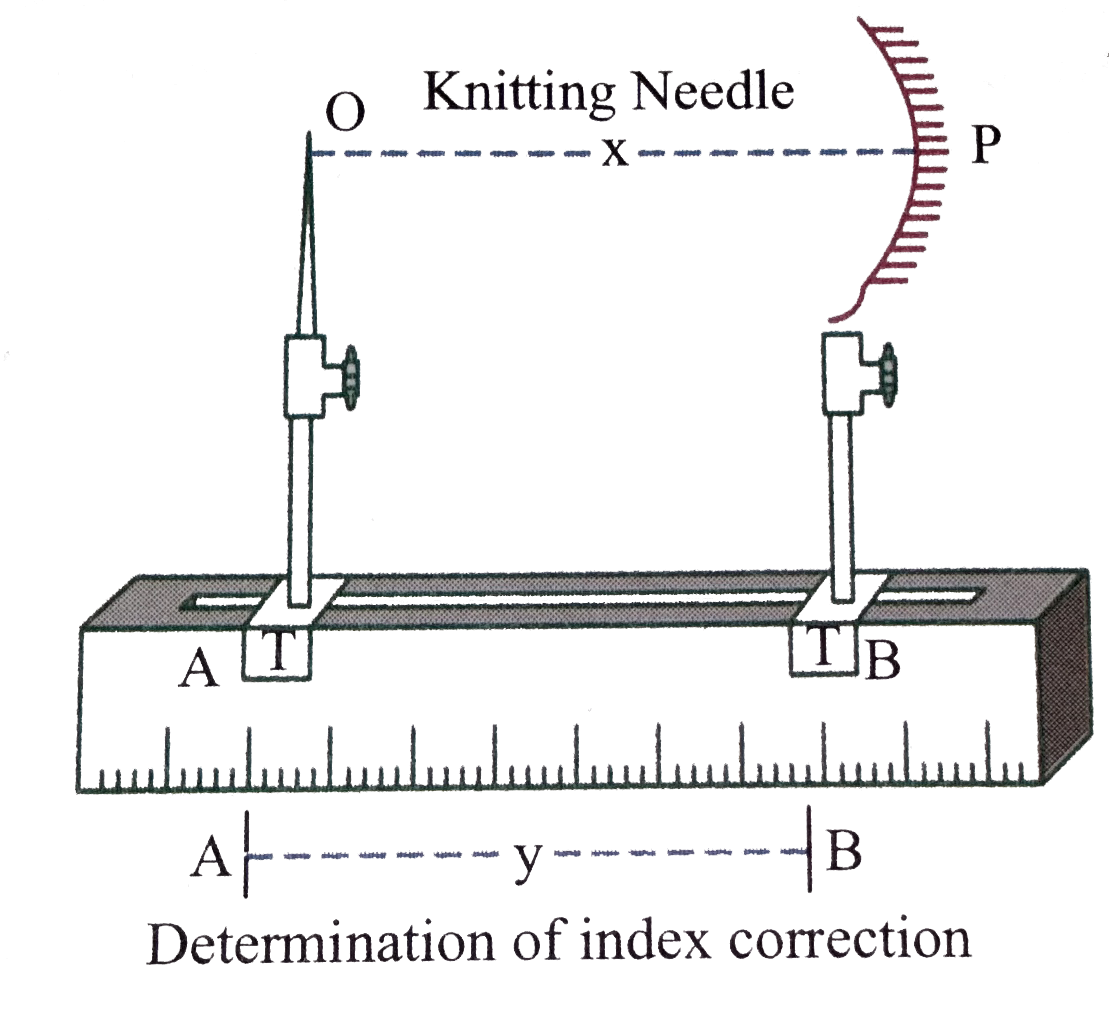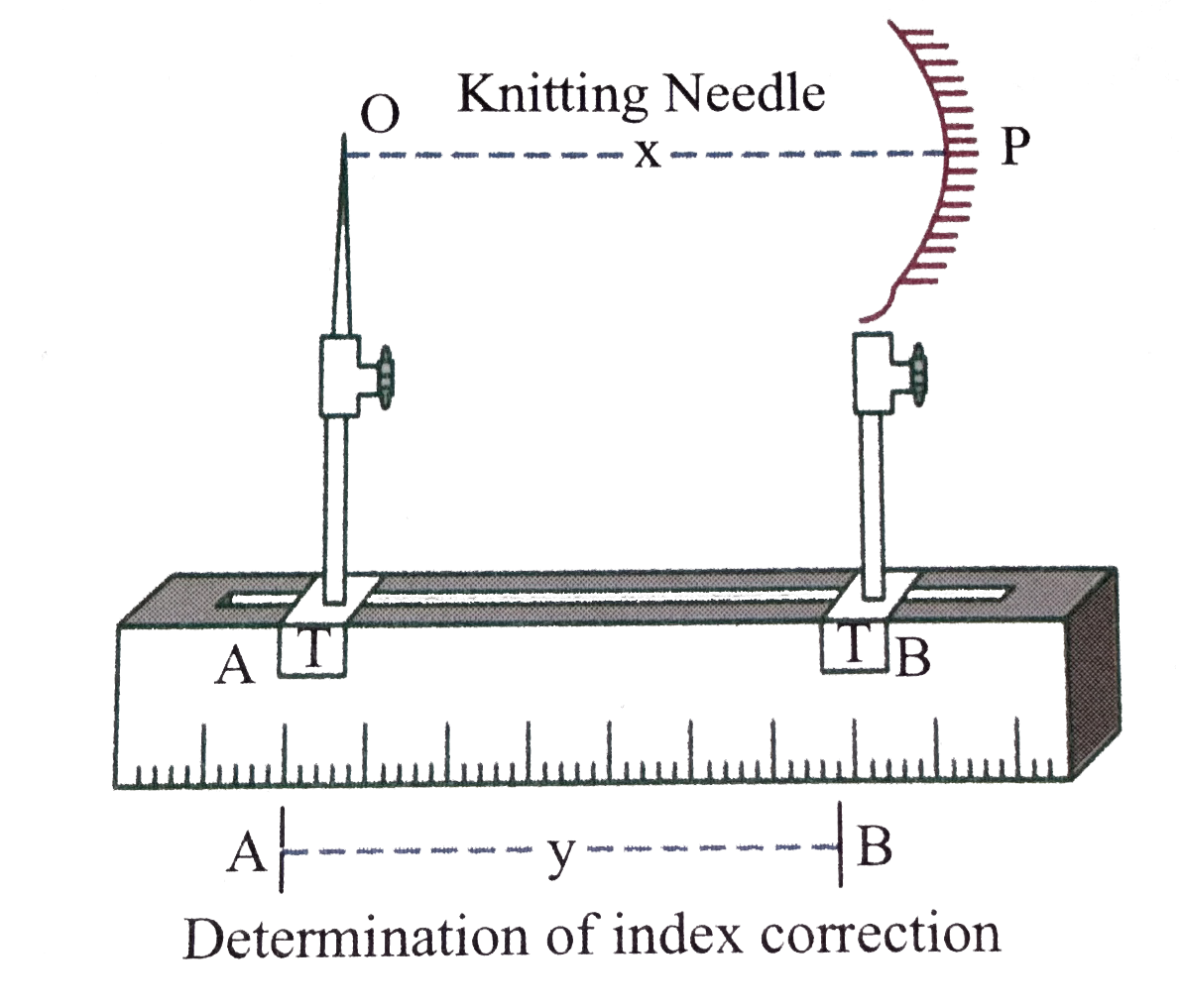In some observation the observed object distance (Separation between indicos of object needle and mirror) is 30.2cm and the observed imager distane is 19.9cm Using index correction from previous two questions estimate the focal length of the concave mirror .
u=30.2−0.2 (excess readin)
=30.0cm
v=19.9−(−0.1) (excess reading)
≡20.0cm
If=1v+1u⇒f=12.0cm .
Topper's Solved these Questions
- BOOK - RESONANCECHAPTER - EXPERIMENTAL PHYSICSEXERCISE - Exercise12videos
EXPERIMENTAL PHYSICS
- BOOK - RESONANCECHAPTER - EXPERIMENTAL PHYSICSEXERCISE - Exercise -1 PART1videos
EXPERIMENTAL PHYSICS
- BOOK - RESONANCECHAPTER - ELECTROSTATICSEXERCISE - HLP39videos
ELECTROSTATICS
- BOOK - RESONANCECHAPTER - GEOMATRICAL OPTICS EXERCISE - Advance level Problems35videos
GEOMATRICAL OPTICS
Similar Questions
To find index error e distance between object needle and poler of the concave mirror is 20cm. The separation between the indices of object needle and mirror was observed to be 20.2cm in some observation, the observed image distance is 20.2cm and the object distance is 30.2cm find
(a) the index error e.
(b) focal length of the mirror f.View SolutionThe image of a distant object is formed at 30 cm from a concave mirror. What is the focal length of the mirror?
View Solution
Knowledge Check
- Question 1 - Select One
In u−v method, we require the distance between object or image from the pole (vertex) of the mirror (actual distance). But practically we measure the distance between the indices A and B. (Observed distance). Which need not exactly co-inside with object and pole, there can be a slight mismatch called index error, which will be constant for every observation.

Index error=Observed distance-Actual distance(Just like zero error in screw guage, it is the excess reading).
To determine index error, mirror and object needle and placed at arbitary position. For measuring actual distance, a knitting needle is just fitted between the pole of mirror and object needle O. The length of knitting needle will give the actual object distance while the seperation between indices A and B at that instant is the observed distance.
So index error is-
e=Observed distance-Actual distance
= Separation between indices A and B- Length of knitting neddle once we get e, in
every observation, we get
Actual distance=Observed distance (separation between the indices)- Excess reading(e) There is an another term, Index corraction which is invert of index error.
Index correction=-index error
In some observation, the observed object distance (Separation between indices of object needle and mirror) is 30.2cm, and the observed image distance is 19.9cm. Using index correction from previous two equations, estimate the focal distance of the concave mirror!A36cmB20cmC12cmD8cm - Question 2 - Select One
An object of height 1.5 cm situated at a distance of 15 cm from a concave mirror . The concave mirror formus its real image of height 3.0 . The focal length of concave mirror will be.
A−10cmB−20cmC20cmD30cm - Question 3 - Select One
A spherical mirror forms a real image three times the linear size of the object. If the distance between the object and the image is 80 cm, the focal length of the mirror is
A15 cmB−15 cmC30 cmD40 cm
An object is placed at a distance of 10 cm from a concave mirror. When the distance of object from the mirror is decreased to 6 cm, the image gets 2 times magnified than that in first case. Calculate the focal length of the mirror.
View SolutionThe image of an object placed 16 cm from a concave mirror is formed at a distance of 24 cm from the mirror. Calculate the possible focal lengths of the concave mirror from this information.
View SolutionAn object is placed in front of a concave mirror at a distance of 7.5 cm from it. If the real image is formed at a distance of 30 cm from the mirror, find the focal length of the mirror. What would be the focal length if the image is virtual.
View SolutionIn u−v method, we require the distance between object or image from the pole (vertex) of the mirror (actual distance). But practically we measure the distance between the indices A and B. (Observed distance). Which need not exactly co-inside with object and pole, there can be a slight mismatch called index error, which will be constant for every observation.

Index error=Observed distance-Actual distance(Just like zero error in screw guage, it is the excess reading).
To determine index error, mirror and object needle and placed at arbitary position. For measuring actual distance, a knitting needle is just fitted between the pole of mirror and object needle O. The length of knitting needle will give the actual object distance while the seperation between indices A and B at that instant is the observed distance.
So index error is-
e=Observed distance-Actual distance
= Separation between indices A and B- Length of knitting neddle once we get e, in
every observation, we get
Actual distance=Observed distance (separation between the indices)- Excess reading(e) There is an another term, Index corraction which is invert of index error.
Index correction=-index error
To find index error for v, when the same knitting needle is adjusted between the pole and the image needle, the separation between the indices of image needle and mirror was found to be 19.9cm. Index error for v isView SolutionA point object is placed on the axis of the concave mirror at a distance of 60 cm from the focal point of the mirror. Its image is formed at the point of object then focal length of the mirror is
View Solution

